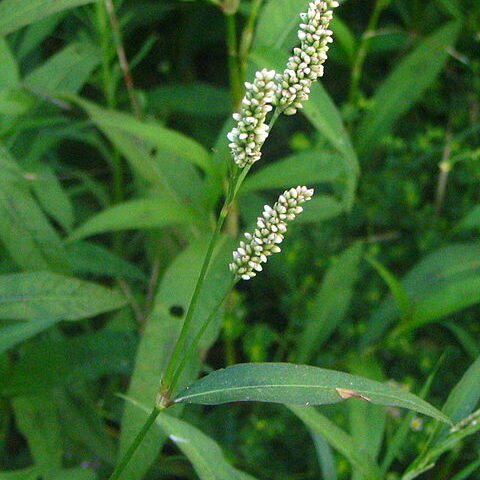Annual or perennial herbs, shrubs, trees (not in Australia) or vines; stems often with swollen nodes, often sulcate, geniculate or striate; often accumulating anthraquinone glycosides and often oxalic acid present, also often with tannins; hairs various. Leaves usually alternate, rarely opposite (usually in Eriogoneoideae) or whorled, simple, rarely pinnately or palmately cleft, usually with entire, sometimes crenate lamina margin, petiolate or sessile, petioles often flattened, sometimes articulate at base; extrafloral nectaries sometimes present at petiole base; stipules present and usually connate into a tubular, membranous or scarious sheath (ochrea), usually shortly tubular, often disintegrating, with bilobed or fringed margins, persistent or deciduous, rarely reduced or absent (in most Eriogoneoideae, not in Australia). Inflorescence terminal or axillary, a raceme or spike-like panicle or heads, sometimes in axillary fascicles, the flowers pedicellate, clustered or solitary, each cluster subtended by an ochreola and each flower by a similar small persistent sheath; involucral bracts sometimes present and showy (Eriogoneoideae); pedicels mostly articulate, with portion ('fruiting pedicel') falling with fruit. Flowers bisexual, rarely unisexual (plants monoecious, polygamo-monoecious or dioecious), actinomorphic, small; hypanthium, when present, free, hypogynous disk or nectaries present between the androecial members. Perianth of 2–6 tepals, in 1 or 2 whorls or sometimes in 1 whorl of 5, usually basally connate into a minute to conspicuous tube, imbricate, calyx and corolla distinct, or both sepaloid or petaloid, usually persistent in fruit and often accrescent. Stamens (2–) 4–9 or rarely many; filaments free or slightly connate, often of two lengths, those of the inner series often dilated, free or adnate to perianth tube and forming a ring, opposite the tepals; anthers dorsifixed or basifixed, versatile or not, tetrasporangiate, dithecal, dehiscing by longitudinal lateral slits; pollen shed in tetrads. Gynoecium of (2) 3 (4) connate carpels. Ovary superior, placentation axile or parietal, 1-locular; styles 1–4, apical, simple, free or basally connate; stigma 1, filiform, peltate or capitate, entire or fringed. Ovule 1. Fruit a nut or achene-like, trigonous or lenticular, sometimes enclosed by a fleshy hypanthium or perianth, 1-seeded, falling as a unit with portion of pedicel. Seeds with non-ruminate endosperm or sometimes ruminate (not in Australia), starchy, oily.
Herbs, climbers, shrubs, or trees (not in tropical East Africa). Branches sometimes tendrilous. Leaves usually alternate, often lush, sessile or stalked, usually dilated into an amplexicaul cup (ocrea) at the junction with the stem. Flowers actinomorphic; hermaphrodite, polygamous, dioecious, or monoecious; borne in many-or few-flowered fascicles, pedicellate, subtended or not by ocreiform bracts with or without bracteoles. Inflorescence capitate, racemose, or ± umbellate, often branched and paniculate. Petals 0. Perianth inferior, calyciform with 3–6 free, sometimes petaloid lobes (tepals) arranged in 1 or 2 series, often accrescent and then sometimes armed with spines, prickles or teeth. Stamens 5–9 inE. African spp., usually all fertile, inserted in 1 or 2 series at or near the base of the perianth; filaments filiform throughout or basally dilated, free or conjoined at the base; anthers 2–celled, longitudinally dehiscent. Styles 2–3, free or connate below, the flowers sometimes heterostylous; stigmas capitate, dilated, fimbriate or penicillate. Ovary 1–locular, superior, sessile. Mature fruit nut-like, fusiform, lenticular, or acutely or obscurely trigonous, unarmed or armed with prickles or (Harpagocarpus) barbed setae. Ovule solitary, basal, sessile or stalked. Seed with abundant endosperm
Herbs, shrubs, or small trees, sometimes monoecious or dioecious. Stems erect, prostrate, twining, or scandent, often with swollen nodes, striate, grooved, or prickly. Leaves simple, alternate, rarely opposite or whorled, petiolate or subsessile; stipules often united to a sheath (ocrea). Inflorescence terminal or axillary, spicate, racemose, paniculate, or capitate. Pedicel occasionally articulate. Flowers small, actinomorphic, bisexual, rarely unisexual. Perianth 3-6-merous, in 1 or 2 series, herbaceous, often enlarged in fruit or inner tepals enlarged, with wings, tubercles, or spines. Stamens usually (3-)6-9, rarely more; filaments free or united at base; anthers 2-loculed, opening lengthwise; disk annular (often lobed). Ovary superior, 1-loculed; styles 2 or 3, rarely 4, free or connate at lower part. Fruit a trigonous, biconvex, or biconcave achene; seed with straight or curved embryo and copious endosperm.
Stamens (4)6–9, usually inserted at or near the base of the perianth segments; filaments filiform or dilated at the base, free or basally united; anthers dorsifixed, 2-thecous, opening lengthwise
Ovary superior, syncarpous, unilocular, sometimes falsely 3-locular, with a solitary basal orthotropous ovule; styles 2–3, free, or connate at the base; stigmas capitate, peltate or penicillate
Perianth sepaloid or petaloid of 3–6 free or connate segments (tepals), in 1 or 2 series, imbricate in bud, membranous, sometimes accrescent, sometimes armed with spines, prickles or teeth
Inflorescences capitate, racemose or ± umbellate, sometimes branched and paniculate, the flowers usually fascicled and subtended by bracts as well as the ocrea, with or without bracteoles
Herbs, shrubs or climbers, rarely trees: leaves alternate, with the base of the petiole often dilated into a membranous sheath (ochrea)
Flowers hermaphrodite, polygamous or unisexual, sometimes heterostylous, actinomorphic, pedicellate; pedicels usually articulated
Stamens usually 6–9, rarely more; filaments free or united at the base; anthers 2-celled, opening lengthwise
Fruit a nut, indehiscent, hard, trigonous or lenticular, usually enclosed in the ± persistent perianth
Ovary superior, sessile, 1-celled; styles 2–4, usually free; ovule solitary, basal, sessile or stalked
Seed similar in shape to the nut, with abundant endosperm; testa membranous, smooth or not
Flowers hermaphrodite, polygamous or dioecious, actinomorphic, small and inconspicuous
Annual or perennial herbs, shrubs or climbers (more rarely trees), glabrous or hairy
Sepals 3–6, imbricate, often enlarged and becoming membranous in fruit
Leaves usually alternate and usually with sheathing stipules (ocreae)
Seeds with abundant mealy endosperm and often excentric embryo
Fruit an indehiscent trigonous or 2-sided nut
Disk annular or composed of glands
Branches sometimes with tendrils
Disk annular or central
Petals absent

